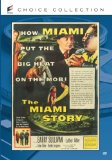| Reviews & Columns |
|
Reviews DVD TV on DVD Blu-ray 4K UHD International DVDs In Theaters Reviews by Studio Video Games Features Collector Series DVDs Easter Egg Database Interviews DVD Talk Radio Feature Articles Columns Anime Talk DVD Savant Horror DVDs The M.O.D. Squad Art House HD Talk Silent DVD
|
DVD Talk Forum |
|
|
| Resources |
|
DVD Price Search Customer Service #'s RCE Info Links |
|
Columns
|
|
|
Miami Story (Sony Choice Collection), The
"The murder syndicate, the vice ring, the fixed race, the shakedown, the paid gun--all made America's winter playground the world's capital of crime...till Miami blasted back and shoved the underworld into the sea--lock, stock, and B-Girl!
The screen now dares to bring you the brutality, the excitement, the truth about the terrifying struggle between the law and the lawless that raged in the streets of Miami!"
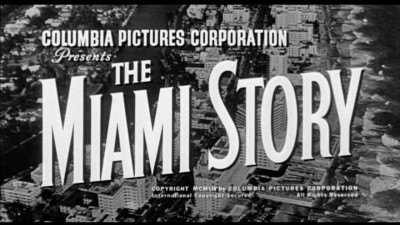
Enjoyably pulpy low-budget crime meller. Sony Pictures' Choice Collection of hard-to-find cult and library titles has released The Miami Story, the 1954 Columbia Pictures thriller from producer Sam Katzman and director Fred F. Sears, starring Barry Sullivan, Luther Adler, John Baer, Adele Jergens, Beverly Garland, and George E. Stone, with a "Special Guest Politician" appearance by Florida Democrat Senator George A. Smathers, assuring us that organized crime has ceased to be in 1954 Miami (oh, Senator...). One of a flurry of similar low-budget, high body-count, semi-documentary crime outings influenced by the screaming headlines and socko TV ratings of Kefauver's United States Senate Special Committee to Investigate Crime in Interstate Commerce, The Miami Story shows Katzman and Sears in punchy command of their sleazy, lurid material, and quite entertainingly so...regardless of how silly it all becomes by the fade-out. No extras for this okay black and white anamorphic transfer (the widescreen framing looks a little tight).
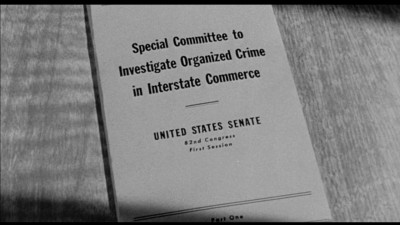
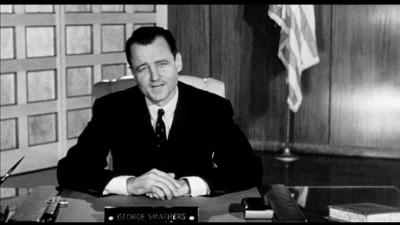
According to The Miami Story, organized crime lords, panicked at the thought of the Kefauver Committee's power to smash them, fled across the country to eventually settle in places like sun-kissed Miami, Florida, where the city's "tough, honest police force" was overwhelmed with the task of rooting out these foreign interlopers. Miami-based mob kingpin Tony Brill (Luther Adler), the untouchable head of the shadowy, innocuous-sounding front, the R & L Corporation, has his vice-laden fingers in dirty pies all the way to Detroit and beyond, courtesy of superior tech support from the likes of beautiful beat-up doll, Gwen Abbott (Adele Jergens), his tough cookie assistant, and handsome, all-American psycho killer, Ted Delacorte (John Baer), paternal Tony's college educated heir apparent. However, when Delacorte ventilates two Cuban syndicate muscle boys at Miami Airport, a group of influential, concerned citizens--The Committee of Five--meets in an effort to brainstorm a solution for the city's out-of-control gang violence. Florida Bar Association Ray Alton (Dan Riss) thinks he has a solution: as a former D.A., Alton saved Chicago gangster Mick Flagg (Barry Sullivan) from the electric chair--a reprieve that set the hardened criminal straight. Alton suggests planting a story in the country's newspapers that will root out the now-anonymous Flagg, in order to bring him to Miami, where he'll be the Committee of Five's blunt instrument in defeating Brill and his gang. Flagg, now living in Indiana as "Mike Pierce" with his 12-year-old son, Gil (Ray Kellogg), isn't happy about being outed, but he eventually agrees to the plan (that $50K in his son's bank account helped...). Posing as the new head of the Cuban syndicate, Mick begins his assault on Brill's organization, with the help of Holly Abbott (Beverly Garland), Gwen's worried kid sister.
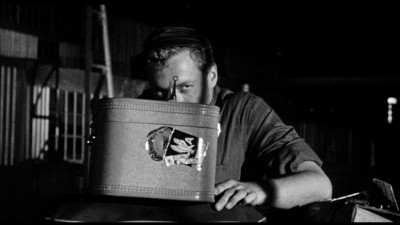
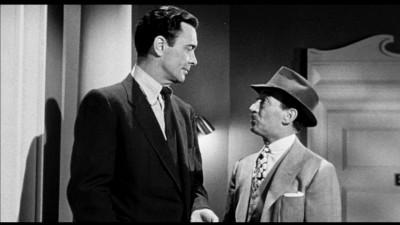
One of the many myths you'll find propagated in conjunction with the famed "Kefauver Committee's" 1950-1951 investigation of organized crime in America, is that its nationally televised proceedings and blaring newspaper headlines from cities all over the country somehow "woke up" a previously naive, trusting, oblivious American public to the vast number of underground criminal organizations that operated on national and local levels...as if the citizens needed a D.C. government committee to tell them the score about who scratched whose backs and who "fixed things" in the towns and cities in which they lived and worked (you don't know who's shady in your town right now? Sure you do...and people knew back then, too). If anything, those high-rated proceedings functioned far more successfully as lurid entertainment for new TV viewers (when nothing was on...) rather than educational public service, and sure enough Hollywood--particularly low-budget Hollywood--was fast to capitalize on a trend that promised a fast buck at the turnstiles. Soon, all kinds of so-called mob "exposes" were showing up at movie houses--New York Confidential, Miami Expose, Chicago Confidential, The Houston Story, New Orleans Uncensored, The Phenix City Story, Portland Expose, New Orleans After Dark, and The Captive City (with Kefauver himself making an appearance)"quickly becoming its own subgenre of crime mellers, featuring semi-documentary gimmicks (narration, location shooting) and sometimes "official" endorsements to try and convince ticket buyers they were getting the real dope on the "underworld" (not only does The Miami Story have Florida Democrat Senator George A. Smathers actually appear on-screen, a quote supposedly from him is prominently featured on the movie's original one-sheet poster, as well).
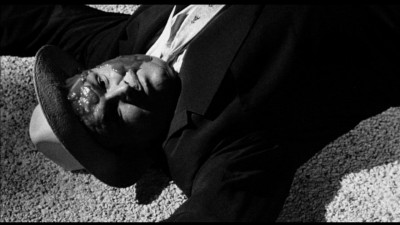
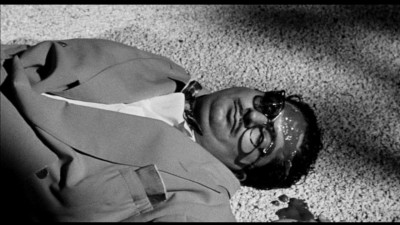
Of course most of these "exposes" were complete bullsh*t in terms of historical accuracy--more melodramatic fabrications than factual representations of actual crimes and punishments. Smathers' reassuring intro to The Miami Story proper (to paraphrase: "An aberrant criminal element has been flushed from Miami's otherwise squeaky clean streets; nothing to see here, so move along...") doesn't specifically say what happens in the movie actually happened in Miami (it's vague enough to make you think so, though), but knowing producer Sam Katzman, I wouldn't be at all surprised if a kernel of the story did pop up in some newspaper somewhere, inspiring him to have a screenplay fashioned to quickly capitalize on a story making headlines (any experts in Miami crime email and let me know). Quite frankly, though, I doubt one in a thousand moviegoers at the time cared a whit as to where or not The Miami Story was strictly factual; the cheap-thrills promise of violence and sensation in an appropriately glamorous locale (and the notion that yeah...maybe this did happen...) was probably enough for most ticket buyers here.
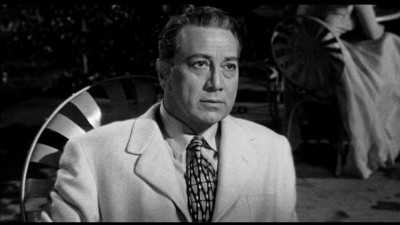
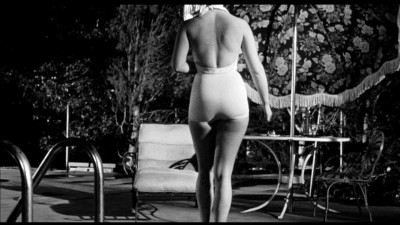
Scripted by Robert E. Kent (everything from Dick Tracy vs. Cueball and Gas House Kids in Hollywood to Where the Sidewalk Ends and Twice-Told Tales), and directed by speed demon exploitation pro Fred F. Sears (Ambush at Tomahawk Gap, Wyoming Renegades, Cell 2455 Death Row, Rock Around the Clock, Earth vs. The Flying Saucers, Escape from San Quentin among many, many others), The Miami Story starts off with admirable sleaziness, and seems destined for minor greatness as Kent and Sears begin their story in the gutter and stay there. After the pre-Untouchables montage of stock footage showing the mob doing their dirty work (complete with pre-Walter Winchell sound-alike), and then Smathers confidently assuring us that no one in a position of authority had a hand in these corrupt criminals' activities (...right), we go to a cleanly-designed sequence where all-American college assassin Ted Delacorte zaps two Cubans getting off a plane (Sears includes a creepy shot of Baer rolling his key-lighted eyes over Beverly Garland's body before we get two close-ups of the corpses, their faces covered in thick tomato sauce). After a double killing, there's nothing like a sex party, so we cut to Tony Brill's island hide-out, where he flicks his reptilian eyes over Ted's newest conquest (Sears is sure to give us a departing ass shot of Brill's property, as well as a later wide, full pin-up shot of the girl, lounging on a chaise) before declaring she's to be moved to Detroit, as a shill. Some good tough guy-and-dame dialogue commences (hard-as-nails dish Gwen only has "maternal instincts for mink and sable") as Kent establishes that the "new mob" is as efficiently run as General Motors and AT&T (Gwen runs down the numbers for Brill's various illicit enterprises like a seen-it-all regional manager ticking off the pluses and minuses during a boring mid-morning conference call). So far, so good.
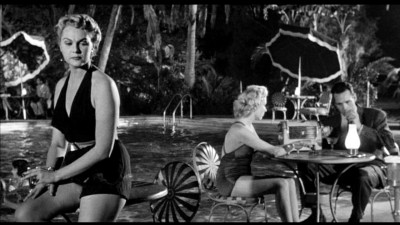
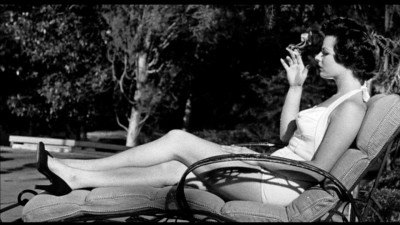
Unfortunately, any chance of The Miami Story becoming more than just an efficient, nasty-edged crime meller--and there ain't nothing wrong with that--pretty much ends when we're given the potentially juicy subtext of some kind of weirdo Oedipal triangle where proud daddy Tony thinks of smiling, happy Teddy as his son, before Teddy hits big-time on "Dad's" wary-but-still-panting moll, Gwen ("We share things," Teddy breathes into Gwen's heaving cleavage, revealing not only Tony's and Teddy's games...but also what they think of the "pieces" they use in those games: they're "things"). In a great noir, this angle would have been expanded (at the very least indirectly), but here, nothing further is made of it, indicating Kent and Sears either didn't have the time to...or the desire. The same thing happens with Sullivan's character. We're intrigued by the potentials in his son finding out his beloved, straight-arrow Dad ("You're the greatest, Pop!", our road company version of Beaver Cleaver exclaims) is in reality a goddamned liar, as well as the possible paralleling of the two father/son relationships here--one a little less crooked than the other--that a truly inspired director and screenwriter would have exploited. Unfortunately...it doesn't happen in The Miami Story. Gil disappears, not to be seen until the end of the movie, while the perverted father/son dynamic of Tony and Teddy is used merely for simplistic plot machinations. We don't even get any ironic commentary out of the cops blithely ruining Sullivan's new assumed life for their own crime-busting purposes (remarkably, a relatively sanguine Sullivan actually states he might have been saved from the electric chair 12 years before just for such valedictorious payback to society).
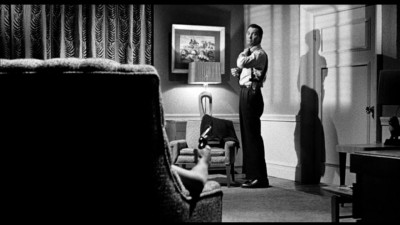
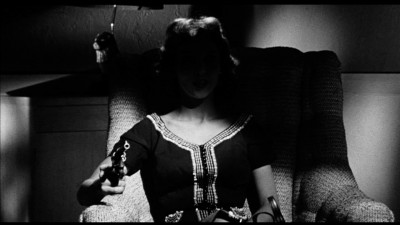
And once you realize that The Miami Story isn't going to particularly challenge you, you can sit back and just enjoy it. Certainly there are silly moments in the story. Why in the world would Sullivan bring his son to Florida? And how about that whole finale with the hidden TV surveillance cameras in the air conditioning vents at Tony's casino? Those must be some pretty big vents to hide TV cameras from 1954, which were the size of small buffalos. And how about the guy that's needed to operate them? Hope he didn't have to go to the bathroom (amazing how the footage had pans and dollies, too...). How about that 250lb DuMont "portable" TV monitor Sullivan is watching out in the bushes...had to be a long cord for that to work (none of Tony's men noticed that sickly green glow and 120 decibel hum coming from behind the shrubs?). That stuff is fun to laugh at, but other "straight" elements are equally entertaining without condescension, like the persistently nasty, violent tone The Miami Story maintains, what with Sullivan flicking a cigarette into Garland's face before bitch-slapping her face. Hard. Or his vicious pummeling of Baer, showing Adler what a two-bit punk his "boy" is when facing a real gangster without a degree (take that, college boy!). The dialogue is consistently amusing and hard-boiled; Gwen sneers at her goody-two shoes sister, "You can hoof; all I could do was shake on top and wiggle on the bottom at crummy burlesque joints!" And certainly the funniest scene in the movie has veteran weasel George E. Stone (just terrific) whining on and on to a slightly bemused, passive Sullivan, who just looks at him, blinking, until Stone finishes, prompting stone-faced Sullivan to flatly respond to this epic gripe, "Yeah...good night, Louie," before turning away. All of the performers are just right here: Sullivan is pleasingly brutal; slimy Adler alternately confident and cowardly; tough-over-sensitive Garland excellent at getting her ass royally kicked (convincing makeup for that); Baer agreeably callow and weak, and Jergens absolutely perfect as the past-it chippie with bitter poison in her veins. The Miami Story may have missed several opportunities to become "great"...but it's never less than entertaining.
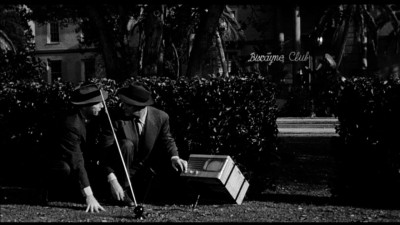
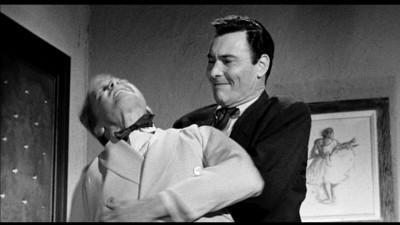
The DVD:
The Video:
The anamorphically enhanced, 1.78:1 widescreen black and white transfer for The Miami Story looks a little tight at that ratio; I'm betting when it was matted for projection, it was probably closer to 1.66:1...but it's not too distracting here. Otherwise, the image is reasonably sharp, with acceptable blacks and moderate grain/video noise.
The Audio:
The Dolby Digital English mono audio track has been re-recorded at a solid level, with low hiss. No subtitles or closed-captions.
The Extras:
No extras for The Miami Story.
Final Thoughts:
Enjoyably entertaining, if unambitious, crime meller. Plenty of opportunities for an engaging noir are present here, but Energizer Bunny director Fred F. Sears doesn't appear to have time to exploit them, concentrating more on getting from one nasty, violent set-up to the next in the quickest possible time. Performances are right in tune with this sleazy potboiler. I'm recommending The Miami Story.
Paul Mavis is an internationally published movie and television historian, a member of the Online Film Critics Society, and the author of The Espionage Filmography.


|
| Popular Reviews |
| Sponsored Links |
|
|
| Sponsored Links |
|
|
| Release List | Reviews | Shop | Newsletter | Forum | DVD Giveaways | Blu-Ray | Advertise |
|
Copyright 2024 DVDTalk.com All Rights Reserved. Legal Info, Privacy Policy, Terms of Use,
Manage Preferences,
Your Privacy Choices | |||||||









